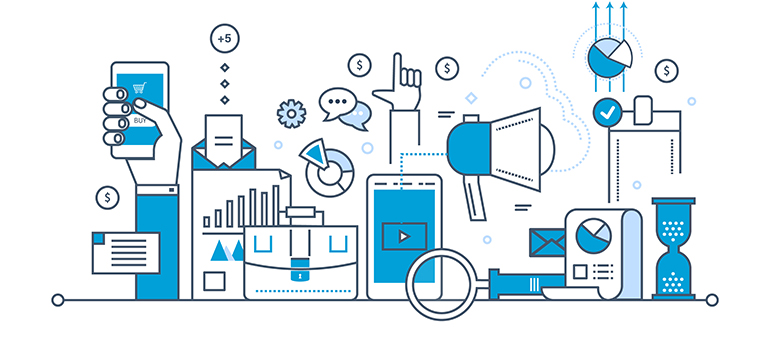 The interest in gaining a competitive advantage with the help of Artificial Intelligence (AI) runs through a wide range of industries, such as e.g. health care, production, automotive or military, which are investing billions into the technology. The marketing industry certainly started to test various fields of application, where the use of AI could advance the business. The Salesforce State of Marketing Report 2018 already provided an insight into how widespread the use of AI has become, although the authors of the study emphasize that all in all no dominant use has yet emerged. The study shows, however, that 39% of marketing decision makers rely on AI and 29% of respondents already use AI-based systems to personalize their offers via email.
The interest in gaining a competitive advantage with the help of Artificial Intelligence (AI) runs through a wide range of industries, such as e.g. health care, production, automotive or military, which are investing billions into the technology. The marketing industry certainly started to test various fields of application, where the use of AI could advance the business. The Salesforce State of Marketing Report 2018 already provided an insight into how widespread the use of AI has become, although the authors of the study emphasize that all in all no dominant use has yet emerged. The study shows, however, that 39% of marketing decision makers rely on AI and 29% of respondents already use AI-based systems to personalize their offers via email.
When using AI in marketing, it is essentially all about the analysis of data and the question of whether an intelligent software system can draw new conclusions from it. Conclusions that marketers would never have come up with, but which are so relevant that they can be derived from a targeted customer approach, which in turn drives the conversions up significantly. Against this background, various areas of application can be outlined: chatbots, copywriting, speech and image recognition and the automated display of advertising. All these measures aim to provide the user with a highly personalized customer journey.
Speech recognition: in the US, the language assistant Google Duplex is currently being introduced to the market. The intelligent software shows just how much existing assistance systems like Alexa or Siri need to be improved. Duplex makes phone reservations in restaurants and speaks with filer noises, so that for the other party the machine is no longer easily distinguishable from a human. These days, the Chinese web group Alibaba has also introduced its latest version of a language assistant that reacts surprisingly smoothly to demands. In terms of customer care, such sophisticated assistance systems could be applied to many possible uses, however, the studies also show that customers want to know when they speak with a bot and not with a human.
Image recognition: suppliers such as eBay and Zalando are currently showing us where the journey is heading. The online group Zalando, for instance, has recently introduced the Algorithmic Fashion Companion, an AI-based software that analyzes user behavior, recognizes photos and derives individual styling tips from it. To do this, AI takes on around 200,000 outfits in the first step, then the self-learning computer program incorporates fashion tips into its suggestions, aiming to reduce the return rates. eBay also wants to advise its users more individually with the help of AI and keep them on the platform. You can even, for example, upload photos of items you would like to buy and the AI trawls in the background through the offer for similar products.
Chatbots: an increasing number of companies are using chatbots on Facebook or on their website. The bots have the task to first channel customer requests and to provide the user with the right information or to forward them to a human sales representative. This can be helpful if the chatbot is designed to understand more complex questions and comments and continues to learn with each application. Investigations show, however, if the bot turns out to be naïve and always just answers "I do not understand you", it rather damages the brand image and increases the bounce rate.
Personal content for the user: numerous online portals and daily newspapers are already working with "robot journalism" without the user noticing it. Especially easier contributions, such as weather and stock market reports, but also summaries of football matches, are now often created automatically. That way, publishers save resources they can use better elsewhere. Online shops are also experimenting with software-assisted copywriting to deliver personalized content to the user in fractions of a second as soon as he or she calls up the website, responding to current events and, for example, make references to individual offers.
Programmatic advertising: It is expected that AI is giving new impetus to programmatic advertising, too. So far, the automated advertising playback works according to exact specifications: if a user calls up a website that corresponds to the desired target group, the ad space of this site is displayed in fractions of a second. AI will cause this system to be significantly optimized, since AI finds new relationships in the user data, continuously analyzes the user behavior, and optimizes the advertising based on this data.
Clearly, the areas of application are manifold, just the willingness of people to engage in AI is still inter-generationally very different.
By Thay Xian Rong


